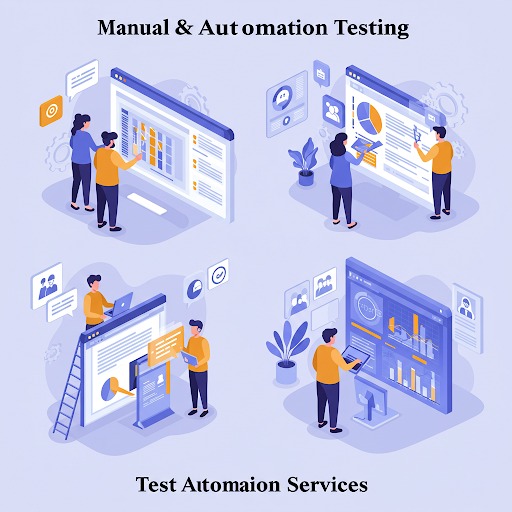Testing Services (Manual and Automation)
Testing services are crucial in the software development lifecycle (SDLC) to ensure the quality, functionality, and performance of an application. There are two primary types of testing services: manual testing and automation testing. Below, I will outline both types of testing services, their methods, tools, advantages, and disadvantages.

Why Choose Our Cloud Solutions?
We modernize infrastructure, streamline outdated processes, and optimize cloud assets to build future-ready ecosystems.
Technology We Use

AWS

IBM Cloud

Google Cloud

Microsoft Azure
Manual Testing
Manual testing is the process of manually checking software for defects without the use of any automated tools. The tester performs the test cases step-by-step and compares the actual result with the expected result.
Features
Testers execute the test cases without using scripts or tools. Focus on the human element to assess usability, user experience, and complex scenarios.
Types of Manual Testing
Functional Testing Validates the functionality of the software against the requirements. Ensures that new changes or enhancements do not affect existing functionalities.
Common Manual Testing Techniques
Black Box Testing Tester focuses on inputs and outputs, without knowing the internal workings of the application.
Advantages of Manual Testing
Flexibility Testers can use their judgment and creativity to test different scenarios that may not be covered by automated scripts.
Disadvantages of Manual Testing
Time-consuming Testers must execute test cases manually, which can be slow and inefficient.
Automation Testing
Features
Helps execute large test cases in less time, increasing productivity and coverage.
Types of Automation Testing
Unit Testing Testing individual units or components of the software to ensure they work as expected.
Common Automation Testing Tools
Appium For mobile application testing across platforms like Android and iOS.
Advantages of Automation Testing
Speed and Efficiency Automated tests can run quickly and repeatedly without human intervention, speeding up the testing process.
Disadvantages of Automation Testing
Initial Cost and Effort Writing automated test scripts and setting up the testing framework can be time-consuming and expensive.
When to Use Manual (vs) Automation Testing?
Manual Testing
Small projects or short timelines where quick feedback is required. User Interface and User Experience (UI/UX) testing, as human testers are needed to evaluate usability. Exploratory testing or cases where the outcome is unpredictable or needs human judgment. When the application changes frequently, making automation costlier and time-consuming to maintain.
Automation Testing
Repetitive and time-consuming tasks that need to be executed multiple times (e.g., regression testing). Large projects with many test cases, where manual testing becomes impractical. Performance testing, load testing, and stress testing to ensure the system handles high traffic. Continuous Integration/Continuous Delivery (CI/CD) environments that require constant, automated feedback.
Core Principles of DevOps
Collaboration
The collaboration extends to other stakeholders such as security teams, ensuring everyone is aligned on building, deploying, and maintaining the system.
Automation
One of the foundational principles of DevOps is the automation of repetitive tasks, such as testing, deployment, configuration management, and monitoring.
Continuous Integration (CI)
Continuous Integration involves automatically integrating code changes from multiple contributors into a shared codebase several times a day.
Continuous Delivery (CD)
Continuous Delivery extends CI by automating the delivery of code to a production-like environment. Once code passes testing and validation, it can be deployed with minimal manual intervention.
Monitoring and Feedback
Continuous monitoring of applications in production is crucial to detect problems early and provide real-time feedback to development and operations teams.
Conclusion
Both manual and automation testing have their strengths and weaknesses, and the choice between them depends on the nature of the project, budget, timeline, and type of testing required. In many modern development environments, manual testing is often used for UI, exploratory, and acceptance testing, while automation testing is leveraged for repetitive, large-scale, and high-frequency tests. Combining both strategies, often referred to as a hybrid approach, is common and provides comprehensive test coverage.
